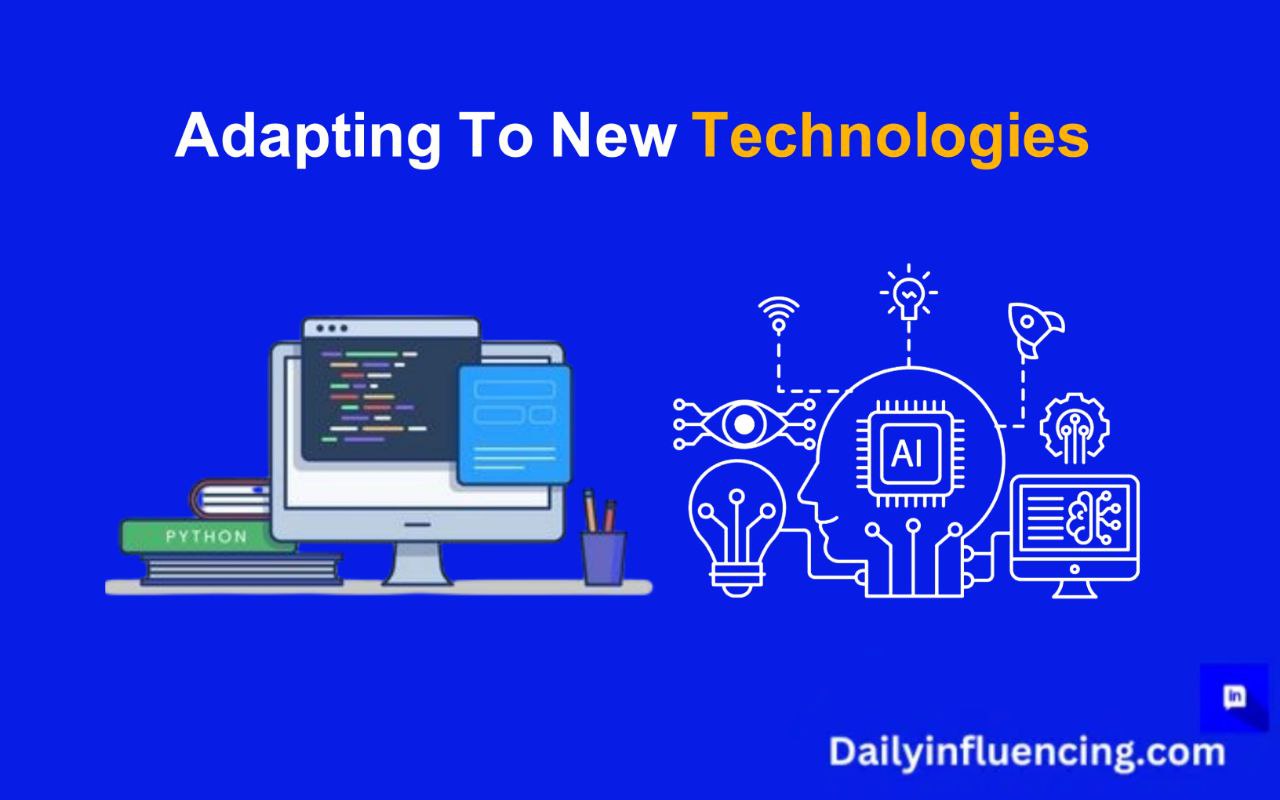
New technologies are emerging every day. For businesses and even our lives individually, keeping up with these changes can be a game-changer. Adapting to new technologies can help your business save time, reach more people, and improve your products or services. But if you’re not used to the latest technology, it might seem a bit difficult. This guide will show you why it’s necessary to embrace new technologies for your business, how to make the switch smoothly, and what to keep in mind as you grow.
Whether you’re starting out or already running a business, learning to work with new technologies can open up many doors. This article will break down each step in a way that’s easy to understand, so you can get started with confidence and grow your business effectively.
Why Adapting to New Technologies is Important

Below are some vital points on why adapting to new technologies is important to your business.
1.Staying Competitive
As more businesses use new technologies, those who don’t may fall behind. Adapting to new technologies can make tasks easier, faster, and often cheaper for you. For example, using new software for accounting can save a business time and reduce errors in the accounting records.
2. Improving Customer Experience
Adapting to new technologies often makes things better for customers too. For instance, having a user-friendly website or a mobile app allows customers to reach you more easily and also allows them to know more about your products and services. A positive experience keeps customers coming back.
3. Increasing Efficiency
One of the biggest advantages of new technologies is that they help businesses work more efficiently. Automated tools can take over repetitive tasks, freeing up your time to focus on things that need a human touch.
4. Creating More Opportunities
Adapting to new technologies as a brand often leads to new business opportunities. For instance, social media has made it easier for small businesses to reach people all over the world, not just in their local area.
Types of New Technologies for Businesses
There are several types of new technologies that can help businesses thrive. Here are a few to consider:
1.Artificial Intelligence (AI)
Artificial Intelligence, or AI, is one of the most popular new technologies in business today. AI can learn from data and make decisions, helping businesses personalize their services, predict trends, and improve customer support. AI chatbots, for example, are used by many businesses to answer customer questions 24/7.
2. Cloud Computing
Cloud computing allows businesses to store data online, making it accessible from anywhere. This is helpful for companies with remote teams or those who want to keep data safe without needing physical storage. With cloud computing, businesses can easily back up important files and access them when needed.
3. E-commerce Platforms
E-commerce platforms, like Shopify or WooCommerce, are new technologies that allow businesses to sell products online. This makes it possible for small businesses to reach customers worldwide. E-commerce platforms also offer tools for managing your stocks, processing payments, and tracking sales.
4. Social Media and Digital Marketing Tools
Social media and digital marketing tools are new technologies that allow businesses to reach and engage customers online. Platforms like Facebook, Instagram, and TikTok have transformed how companies advertise. Marketing tools like Hootsuite or Buffer help businesses schedule posts and track engagement.
5. Data Analytics
Data analytics is one of the most useful new technologies for businesses today. By collecting and analyzing data, companies can learn more about their customers, understand buying habits, and improve their marketing strategies. Tools like Google Analytics provide insights that help businesses make smarter decisions.
How to Start Adapting to New Technologies

Making the switch to new technologies may feel overwhelming, but it doesn’t have to be. Here’s a step-by-step guide to help you start adapting new technologies for your business.
Step 1: Identify Your Needs
Before adapting new technologies, take time to think about what your business truly needs. Are you trying to reach more customers or Improve efficiency? Make a list of what you hope to achieve by using new technologies. This will guide you toward the tools that best match your goals and business type.
Step 2: Do Your Research
Once you know what you need, start researching the different options available. Read reviews, ask for recommendations, or check out free trials. Remember, not every new technology is right for every business, so make sure to choose one that aligns with your business.
Step 3: Start Small
It’s okay to start with one new tool at a time. For instance, if you want to improve customer communication, try a chatbot on your website. By starting small, you can see how each technology works for you before investing too much.
Step 4: Train Your Team
When adapting to new technologies, it is important to train your team. If you have a team, make sure they are comfortable with the new technology too. Schedule training sessions and encourage questions and feedback from your team. When your team understands how to use the technology, it will be much easier to get the most out of it.
Step 5: Monitor Progress
Once you’ve implemented a new technology, keep an eye on how it’s working. Are you reaching your goals? Has it made your work easier or improved customer satisfaction? Regularly assessing the performance of your new technologies helps ensure that they are delivering value.
Overcoming Challenges of Adapting to New Technologies
While new technologies can be beneficial, adapting to them isn’t always easy. Here are some common challenges and how to handle them:
Challenge 1: Learning Curve
Some new technologies require time to learn. Don’t rush; take time to understand the basics, and don’t hesitate to ask for help. Many platforms offer tutorials or customer support to guide you through.
Challenge 2: Cost
Not all new technologies are free, and some can be costly for small businesses. Try to find free or affordable versions of the tools you need. Many new technologies offer basic free versions with the option to upgrade as you grow.
Challenge 3: Resistance to Change
Sometimes, people are hesitant to try something new. To overcome this, show your team the benefits and provide training. When everyone sees how adapting new technologies can help, they are more likely to embrace the change.
Challenge 4: Security Concerns
Adapting new technologies often comes with security risks. To keep your business data safe, choose reliable tools and make sure they have strong security features, such as encryption. Regularly updating passwords and using secure networks can also help protect your business.
Tips for Choosing the Right Technology
Not all new technologies will be right for your business. Here are some tips to help you choose wisely:
Tip 1: Focus on Your Goals
Choose new technologies that directly support your business goals. For example, if your goal is to improve customer service, look for tools that enhance communication, like live chat or a customer service platform.
Tip 2: Keep it Simple
Keep it simple especially if you’re new to technology, look for user-friendly tools. Many platforms are designed to be easy for beginners, so don’t choose a complicated tool if you don’t need it.
Tip 3: Plan for Growth
Select new technologies that can grow with your business. For instance, if you’re starting with a small e-commerce site, choose a platform that allows you to add more features as your business expands.
Tip 4: Look for Support Options
Choose tools that offer customer support, tutorials, or communities where you can get help if you need it. Adapting new technologies is much easier when you have access to resources and support.
The Future of Adapting New Technologies in Business
The world of business is changing fast, and new technologies will continue to play a big role in the future. Here’s a look at what’s ahead:
- More Automation
Automation is one of the most exciting new technologies in business. In the future, more tasks could be automated, allowing businesses to operate with even more efficiency and accuracy. From automated inventory/stock management to digital customer service, automation can free up time and resources for other important areas.
- Virtual Reality (VR) and Augmented Reality (AR)
VR and AR are new technologies that could change how customers shop and interact with businesses. Imagine trying on clothes virtually or viewing a product in 3D before buying it. These experiences may soon be common in online shopping.
- Enhanced Personalization
As technology improves, businesses will have more ways to personalize customer experiences. Whether it’s through AI or data analytics, businesses will be able to offer tailored recommendations, ads, and services that feel truly unique to each customer.
Conclusion
Adapting to new technologies is not just an option for businesses today—it’s a necessity. With technology advancing every day, businesses that keep up with these changes are more likely to stay competitive, improve efficiency, and provide better customer experiences. From AI and cloud computing to social media marketing and automation, there are countless tools that can help make your business more effective and innovative.
Finally, the journey to adapting new technologies might seem challenging at first, but by taking it one step at a time, businesses of all sizes can benefit. Start by understanding your specific needs, choosing tools that align with your goals, and training your team. Even small changes, like upgrading your software or improving your online presence, can lead to big improvements over time.





